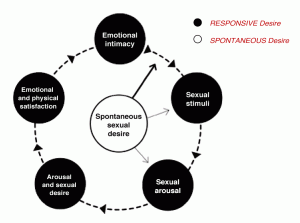 For a long period after Masters and Johnson published their groundbreaking book, Human Sexual Response in 1966, the assumption has been that men and women share a similar pattern of sexual response. As a result, many women (among them many of my clients) wonder if their sexual responsiveness is not quite normal, perhaps problematic, or even pathological.
For a long period after Masters and Johnson published their groundbreaking book, Human Sexual Response in 1966, the assumption has been that men and women share a similar pattern of sexual response. As a result, many women (among them many of my clients) wonder if their sexual responsiveness is not quite normal, perhaps problematic, or even pathological.
Masters and Johnson’s model of sexual responsiveness for both men and women was a linear one, composed of at least three distinct phases:
- Sexual desire: thoughts, fantasies, motivation to engage in sexual activity.
- Sexual arousal: physical changes alongside subjective appraisal of feeling aroused or “turned on.” Physical indicators include increased muscle tension, respiration rate, heart rate, blood pressure, and vasocongestion (i.e., engorgement of blood vessels producing penile erection and swollen testes in men, and swelling of the clitoris and vaginal lubrication in women).
- Sexual orgasm.
(In the 1960s, Helen Singer Kaplan, Ph.D. added a fourth phase to Masters and Johnson’s Sexual Response Cycle — the Resolution Phase. This phase refers to the physiological changes that are produced when sexual arousal subsides and one returns to their pre-sexual state. )
While Masters and Johnson’s work in the 1950s and 60s was noteworthy and trail-blazing in the study of human sexuality, more recent research has identified problems with their original model, particularly as regards the sexual response cycle of women. These studies have shown that many, if not most women, do not move progressively and sequentially through the phases as described.
Sex educator and researcher Beverly Whipple at Rutgers University, for example, suggested that women may not even experience all of the phases: they may move from sexual arousal to orgasm and satisfaction without experiencing sexual desire, or they can experience desire, arousal, and satisfaction but not orgasm.
More significantly, Rosemary Basson at the University of British Columbia (2005), determined that, unlike male sexual response which is more frequently spontaneous, much of female sexual desire is actually responsive rather than spontaneous. A woman may not necessarily experience any desire at first at all; rather, once approached and sexually stimulated by her partner, sexual desire emerges and motivates her to continue the activity. In many ways, Bassoon’s now widely-accepted model of female sexuality, is more circular than linear.
[Click on image to view enlarged]
According to Basson, for many women in long-term relationships, a desire for increased emotional closeness and intimacy or overtures from a partner may predispose a woman to participate in sexual activity. From this point of sexual neutrality — where a woman is receptive to being sexual but does not initiate sexual activity — the desire for intimacy prompts her to remain open to becoming sexually aroused (via conversation, music, direct stimulation, etc.).
With this formulation, Bassoon replaced the earlier, biologic framework with one that incorporates the importance of emotional intimacy, sexual stimuli, and relationship satisfaction, one that is dramatically and significantly affected by numerous psychosocial issues (such as satisfaction with the relationship, self-image, previous negative sexual experiences).
